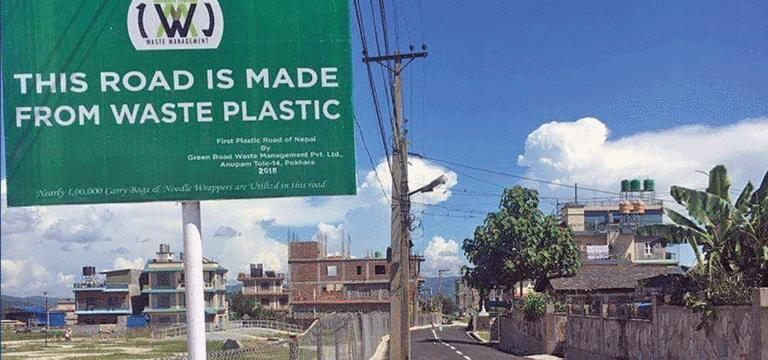
The smoothly laid asphalt road in Pokhara’s Anupam Tole, Ward No. 14 has weathered harsh monsoons and a steady stream of motor vehicles without showing the usual signs of wear and tear.
Paved two years ago, it is yet to develop the mosaic of cracks, and potholes that typically make their appearance after heavy rainfall. Holding the road together is an unremarkable material: plastic.
Only 100-metre-long, this road is the first of its kind in Nepal that is blacktopped by melting waste plastic. Ward No. 14 chairperson Prem Bahadur Karki confirms that the short stretch of a road is in ‘tip top’ condition. “It is truly the most unique infrastructure yet looks like any other road in the city,” he said.
But the Anupam Tole road in Pokhara isn’t the only one of its kind in Nepal. Shortly after its success, a trial road paved out of waste plastic was also constructed in Kirtipur.
From Kirtipur Gate, the road extends to about more than 200-metres. However, unlike its predecessor, Kirtipur’s plastic road was far from being a resounding success. Green Roads Waste Management, the same organisation that built the Pokhara plastic road, also paved the 200-metre road in Kirtipur.
“However, the road is now in disrepair. Just a couple of days after its completion, the road was damaged not because of a design or a construction flaw. The underground pipe beneath the road burst in Kirtipur, thereby creating cracks,” explained Bimal Baskota, the Green Roads Cofounder.
The Kirtipur case is, in fact, an exception because plastic roads are said to be far more durable than concrete ones. “To understand this, we must first be familiar with the process. First, shredded plastic waste is scattered onto aggregate of crushed stones and sand before being heated to melt the waste. Then heated bitumen is added on top, which helps to solidify the aggregate, and the mixture is complete,” he added.
Using plastic to pave roads is said to reduce the amount of bitumen import thereby cutting costs. As per the Nepal Foreign Trade Statistics, Nepal imported 185,344,684 kgs of petroleum bitumen and 705,484 kgs of bitumen and asphalt in the fiscal year 2019/2020 alone.
“Furthermore, adding plastic to roads appears to slow their deterioration and minimise potholes. The plastic content improves the surface’s flexibility,” informed Baskota. In Nepal, though, many of these roads are still relatively young, and their long-term durability remains to be tested.
Although only 10 to 15 per cent of the mix used to pave roads is plastic, it greatly helps in cutting the amount of plastic waste going into landfills. As per the recent ‘Assessment of Solid Waste Management Services and Systems’ published by World Bank Group (2020), an estimated 4,900 tons of solid waste is generated by urban areas per day, among which 600 tons of plastic waste gets dumped in the landfills every day in Nepal. Using such wastes in road construction will prevent landfills from getting overburdened.
Bearing this in mind, in 2015, the Indian government made it mandatory for plastic waste to be used in constructing roads near large cities of more than 500,000 people. Likewise, several other countries have followed suit including Bhutan. In fact, Green Roads Waste Management Nepal’s parent company is based in Bhutan.
Now Bhutan’s Green Road initiative is collaborating with the government to use the plastic mix to blacktop roads across the country.
Despite such advantages, why is there no more than 300 metres of plastic road in Nepal?
It’s because of a lack of proper policies and guidelines regulating plastic use in road construction. The two plastic roads in Pokhara and Kirtipur were constructed purely as test sites in coordination with concerned municipalities. However, to scale up the project, tender needs to be issued and contractors hired. But the Department of Roads is yet to approve the use of plastics in building roads.
Source : THE RISING NEPAL,





